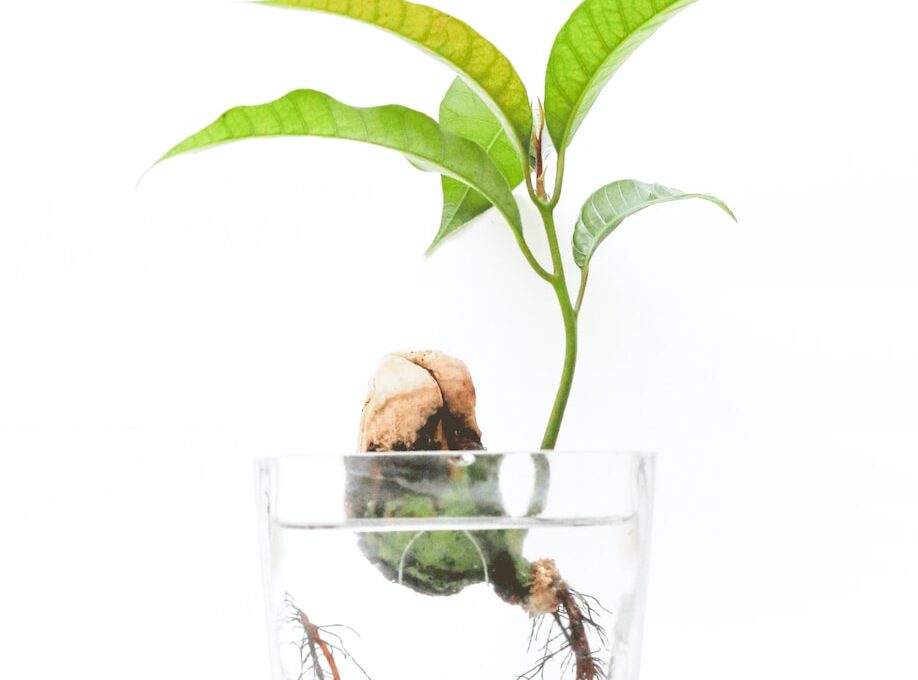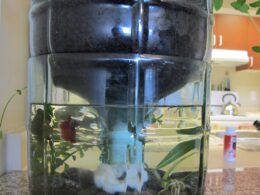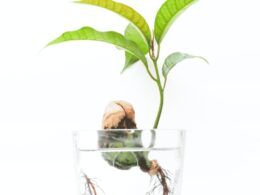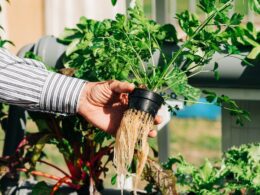Are you growing hydroponic plants and noticed some fuzzy, discolored spots on them? It’s possible that you have mold growing on your plants.
While mold is a common issue for all types of plants, it can be especially concerning for hydroponic growers because the plants are grown in a water-based system, which presents a unique environment for mold to thrive.
Mold on hydroponic plants can have negative effects on both the plants and your health. It’s important to understand the types of mold that can grow on hydroponic plants, the effects they can have, and how to prevent and treat mold growth.
In this article, we’ll explore the potential dangers of mold on hydroponics and provide you with the information you need to keep your plants healthy and safe.
Types of Mold That Can Grow on Hydroponic Plants
It’s important to be aware of the various types of fungi that can develop on plants grown in water-based systems. Common mold varieties include powdery mildew, white mold, and gray mold. These fungi can easily spread on the plant’s surface, especially under high humidity and temperature conditions.
Identifying mold growth can be challenging since it can appear as white, black, green, or brown fuzz on the leaves, stems, or roots. Mold growth can have a significant impact on plant growth and yield. It can reduce the plant’s photosynthetic capacity, stunt growth, and cause wilting.
Since hydroponic plants rely on a sterile environment to grow, mold can quickly spread and infect the entire system. In severe cases, mold can contaminate the nutrient solution, leading to the death of all plants in the setup.
Preventing mold growth is crucial in hydroponics. Maintaining proper airflow, humidity, and temperature levels can reduce the risk of mold development. Regularly inspecting the plants for any signs of mold and removing affected parts can also help prevent the spread of the fungus. Additionally, using organic fungicides or beneficial microbes can control mold growth without harming the plants.
By taking proactive measures, you can keep your hydroponic setup healthy and thriving.
Effects of Mold on Hydroponic Plants
Mold can have a negative impact on the growth and overall health of plants in a hydroponic system. It can affect not only the plants but also the water quality and the entire system. Mold can cause the roots to rot, leading to the death of the plant. It can also reduce the plant’s ability to absorb nutrients and water, stunting its growth.
To prevent mold from growing on your hydroponic plants, it’s important to maintain a clean and sterile environment. This means regularly cleaning your system and ensuring that it’s properly ventilated. You can also add beneficial bacteria to your system, which can help prevent the growth of harmful bacteria and fungi.
If mold appears in your hydroponic system, it’s important to take action immediately. This may involve removing the affected plants and disinfecting the system. By taking proactive steps to prevent and address mold growth, you can help ensure the health and longevity of your hydroponic plants.
Can Chlorine in Hydroponics Lead to Mold Growth?
In hydroponics, the use of chlorine to disinfect water can have a significant impact on the system. While it helps eliminate harmful pathogens, chlorine’s impact on hydroponics can also inhibit beneficial bacteria and fungi growth. Moreover, chlorine residues can hinder the development of a balanced microbial ecosystem, potentially promoting mold growth. Overall, cautious consideration of the chlorine levels is necessary to maintain a healthy hydroponic environment.
Effects of Mold on Human Health
Exposure to mold spores can have a detrimental impact on your respiratory system, making it difficult to breathe and causing your eyes to water and itch. Mold exposure symptoms can range from mild to severe, depending on the amount of exposure and your sensitivity to the spores. If you suffer from allergies or asthma, you may be at a higher risk of developing severe symptoms after being exposed to mold.
Indoor air quality concerns are a growing issue, and mold is one of the main culprits. Mold thrives in damp environments, and hydroponic systems can create the perfect conditions for mold growth. If left unchecked, mold can spread quickly and lead to serious health problems.
It’s essential to regularly inspect your hydroponic system for mold growth and take steps to prevent its formation. To protect yourself from the negative effects of mold on human health, it’s crucial to maintain good indoor air quality. You can achieve this by ensuring proper ventilation in your hydroponic system and using air purifiers to remove mold spores from the air.
Don’t ignore the signs of mold growth, as it can quickly become a serious issue. By taking proactive measures to prevent mold growth, you can keep yourself and your hydroponic plants safe and healthy.
Prevention and Treatment of Mold on Hydroponic Plants
To keep your hydroponic plants healthy and free from harmful spores, it’s important to implement preventative measures and promptly treat any signs of infestation. Here are four tips to help you prevent and treat mold on your hydroponic plants:
-
Proper airflow management is crucial in preventing mold growth. Make sure your grow room has a good ventilation system, and set up fans to circulate air around your plants. This will help prevent the buildup of moisture, which is a breeding ground for mold.
-
Keep your grow room clean and tidy. Regularly wipe down surfaces and equipment with a hydrogen peroxide solution to kill any mold spores that may be present. Be sure to clean up any plant debris or dead leaves, as these can also contribute to mold growth.
-
Monitor the humidity levels in your grow room. Most hydroponic plants thrive in a humidity range between 50-70%, but excessive moisture can lead to mold growth. Use a hygrometer to measure the humidity levels and adjust as necessary.
-
If you do notice mold on your hydroponic plants, don’t panic. There are several hydrogen peroxide treatments available that can effectively kill the mold without harming your plants. Be sure to follow the instructions carefully and monitor your plants closely afterwards.
By following these preventative measures and promptly treating any signs of mold, you can ensure that your hydroponic plants stay healthy and free from harmful spores. With a little bit of care and attention, you can create a thriving hydroponic garden that’s both safe and productive.
Conclusion: Is Mold on Hydroponics Bad?
You can rest easy knowing that with preventative measures and prompt treatment, your hydroponic garden will thrive and be a safe and productive space for your plants. Mold on hydroponics is not inherently bad, but it can become a problem if left untreated. It is important to conduct a risk assessment and weigh the pros and cons of preventative measures, such as using beneficial bacteria and fungi, and treating mold with natural solutions like vinegar or hydrogen peroxide.
To make an informed decision about preventative measures, it is important to understand both the pros and cons. Some pros of using beneficial bacteria and fungi include increased plant growth and productivity, as well as improved nutrient uptake. On the other hand, the cons may include a higher initial cost and the need for ongoing maintenance. When it comes to treating mold, the pros of using natural solutions include their low cost and effectiveness, while the cons may include the need for repeated applications and the potential for damage to plants if not used properly.
In the end, the key to preventing and treating mold on hydroponics is to conduct a thorough risk assessment and take appropriate measures. With the right approach, you can maintain a healthy and thriving hydroponic garden without the fear of mold affecting your plants. Remember to stay vigilant and take action at the first sign of mold to ensure the continued success of your hydroponic garden.
Frequently Asked Questions
How does mold affect the taste and quality of hydroponic plants?
When it comes to growing hydroponic plants, mold prevention is key to maintaining their taste and quality. Regular hydroponic plant maintenance is necessary to ensure the plants are healthy and free of mold.
Mold can affect the taste of your hydroponic plants and even make them unsafe to consume. To prevent mold growth, make sure your hydroponic system is properly cleaned and disinfected regularly. Additionally, keep the humidity levels low and provide proper ventilation to discourage mold growth.
By taking these steps, you can ensure that your hydroponic plants are healthy, safe, and delicious.
Can mold on hydroponic plants spread to other plants or areas in the grow room?
Preventive measures and cleaning techniques are essential to avoid mold spreading from one hydroponic plant to another in your grow room. Mold can easily transfer from one plant to another through the air or by contact.
To prevent this, you should regularly clean and disinfect your hydroponic system and avoid overcrowding plants. Make sure to keep the humidity levels low and provide adequate ventilation to prevent mold growth.
If you notice mold on a plant, isolate it immediately and remove it from the grow room. By taking these preventive measures and cleaning techniques seriously, you can ensure the safety and health of your entire hydroponic garden.
What are some signs that mold may be present on hydroponic plants?
If you suspect that mold may be present on your hydroponic plants, there are a few signs to look out for. One common type of mold is white powdery mildew, which appears as a fuzzy white coating on leaves and stems. Another type is black mold, which appears as black, slimy spots on leaves and stems.
To prevent mold growth, it’s important to maintain proper humidity levels and ventilation in your grow room. You can also use preventative measures such as spraying plants with a mixture of water and hydrogen peroxide or using a fungicide.
It’s important to address mold growth as soon as possible to prevent it from spreading to other plants or areas in the grow room.
Is there a way to completely eliminate mold from a hydroponic system?
Eliminating mold from a hydroponic system is possible with the right prevention techniques. To prevent mold growth, make sure to keep the system clean and well-maintained. This means regularly cleaning the reservoir, checking the pH levels, and ensuring proper ventilation.
It’s also important to choose the right growing medium that doesn’t hold excess moisture, as this can create the perfect environment for mold to thrive. Additionally, using natural mold inhibitors, such as cinnamon or hydrogen peroxide, can help prevent mold growth.
By taking these preventative measures, you can effectively eliminate mold from your hydroponic system and ensure the safety of your plants.
Are there any natural remedies for preventing or treating mold on hydroponic plants?
If you’re growing hydroponic plants, you might be worried about mold growth. Luckily, there are natural remedies and prevention techniques that can help keep your plants healthy and mold-free.
To prevent mold, make sure your hydroponic system is clean and well-maintained. You can also use natural mold inhibitors like cinnamon or neem oil.
If you do spot mold, remove the affected plants and use a natural fungicide like chamomile tea or hydrogen peroxide to treat the remaining plants.
With a little bit of effort, you can keep your hydroponic garden mold-free and thriving.
Conclusion
So, is mold on hydroponics bad? The answer is yes and no. It all depends on the type of mold that’s growing and how it affects both the plant and human health.
While some types of mold can be harmless or even beneficial, others can damage the plant’s growth and produce harmful toxins that can cause health issues for humans.
Preventing mold growth through proper maintenance and treatment is crucial for a successful hydroponic setup. By being vigilant and taking necessary measures, you can avoid the negative effects of mold and enjoy a thriving hydroponic garden.









